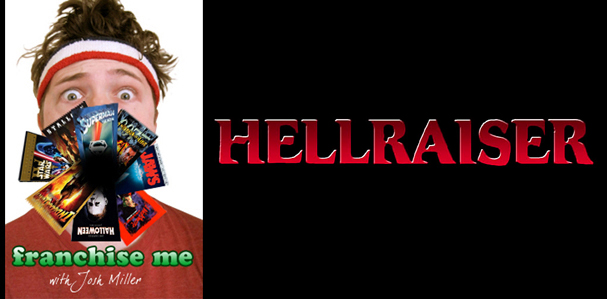
Hollywood loves a good franchise. The movie-going public does too. Horror, action, comedy, sci-fi, western, no genre is safe. And any film, no matter how seemingly stand-alone, conclusive, or inappropriate to sequel, could generate an expansive franchise. They are legion. We are surrounded. But a champion has risen from the rabble to defend us. Me. I have donned my sweats and taken up cinema’s gauntlet. Don’t try this at home. I am a professional.
Let’s be buddies on the Facebookz!
The Franchise: Hellraiser — concerning a supernatural puzzle box (and those humans foolish/unlucky enough to solve it) that opens a doorway to the hellish dimension of Pinhead, the most prominent member of the Cenobites, powerful beings who desire human souls for sadomasochistic experiments. Adapted from Clive Barker’s novella The Hellbound Heart, the franchise spans nine films, from 1987 to 2011.
previous installments
Hellraiser
The Installment: Hellbound: Hellraiser II (1988)
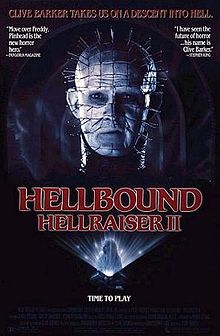
The Story:
We open in the early 20th-century with a prologue in which a British officer is farting around with our sinister puzzle box alone in an army barracks. He solves it and we witness him transformed into a certain familiar Cenobite — Pinhead. Then we jump to the present, where – following in the time honored tradition of horror movie sequels that take place immediately after the closing events of the first film – Kirsty has been brought to a mental hospital. Seems that’s what happens when a bunch of dead bodies are found at your parents’ house and the cops ask you what happened and you say something to effect of, “It was these explorers from the further regions of experience! They’re demons to some, angels to others!” Though kismet is at play, as Kirsty has landed herself in an asylum run by Dr. Phillip Channard (Kenneth Cranham), who we quickly conclude has an existing knowledge of the Cenobites and the Lament Configuration. In fact, he has a young girl on hand at the hospital, Tiffany (Imogen Boorman, who looks a little like Brad Pitt from Legends of the Fall), specifically because of her affinity for solving puzzles. He also requests that the cops bring the bloody mattress that Julia died upon to his house so he can resurrect her (though he doesn’t tell them that). Using one of his own patients as a sacrifice, he successfully brings Julia back from the Cenobite realm. He also gets Tiffany to solve the Lament Configuration, opening up the doorway to the Cenobite’s world — which now is just referred to as Hell. Kirsty ventures into Hell to search for her father, and all sortsa nightmarish wackiness unfolds.
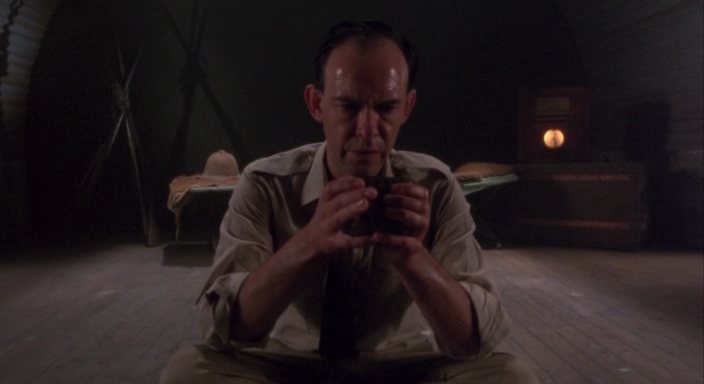
What Works:
Now that Austin and Fantastic Fest are safely behind me, it is time to get back to tearing my soul apart…
Roger Ebert said this of Hellraiser II: “This movie violates…a basic convention of story construction, which suggests that we should get at least a vague idea of where the story began and where it might be headed. This movie has no plot in a conventional sense. It is simply a series of ugly and bloody episodes strung together one after another like a demo tape by a perverted special-effects man.” Ebert also hated Hellraiser, so his opinion can only count for so much here, but he nonetheless speaks some truth. Hellraiser II is disorganized narratively. But that is part of its mad allure, I think. The by-the-book approach to a Hellraiser sequel would have been either: A) have the Cenobites continue their out-of-character pursuit of Kirsty seen in the climax of the first film, finding a way out of their realm solely to hunt her down, or B) have the Cenobites kill Kirsty in the prologue, and then have the story move on to a completely different person discovering the puzzle box — rinse and repeat the first film. Either of those would’ve been viable options, but I think they would’ve been disappointing on some level, coming on the heals of a film as unorthodox as Hellraiser. Hellraiser II needed to be crazy, dig deeper, and it needed to expand beyond the intimate and cramped setting of the first film. And it did all these things.
Like the first film, Hellraiser II is full of a lot of intriguing half-there ideas. As Ebert said, if you try and follow them beat-for-beat to a logical conclusion, you may get sidetracked along the way, but when mixed all together the ideas create an exciting mosaic that feels like a story. And that’s good enough for me, as long as the film is delivering. And boy does it deliver. The film may bite off more than it can chew, but I love the scope Hellraiser II hints towards — revealing that there is more than one puzzle box, and that Pinhead (and all Cenobites) used to be human. I also like the heightened reality of the film, notably the none-to-realistic brain surgery/lecture at the beginning of the film, which seems extremely archaic and Victorian for 1988, and the hospital’s secret “maintenance” wing full of especially crazy people in cramped cells. These elements affect a mood that makes Hellraiser II feel very unlike other films in its class.
There are a lot of disparate things to savor in Hellraiser II, but the pièce de résistance of the film is Rome‘s Kenneth Cranham as Dr. Channard, who, as far as skill-set and experience are concerned, is definitely slumming it here. And bless his Shakespearean trained heart for stooping for us. He single-handedly elevates the entire movie to a precarious level of unexpected high-class, which just makes the bloody insanity everywhere else all the more effective. On paper Channard is an underwritten part. We are left to our own devices to glean his background. A few quick flashes during a montage show us Channard as a child, having been caught by someone (presumably parents) dissecting what looks like a cat. So we can take that to mean he’s a textbook psychopath, psychologically. We know that he’s been obsessed with the creations of Philip Lemarchand (builder of the Lament Configuration puzzle box), who at this point has only been off-handedly mentioned by Frank in the first film. But we see that Channard has three different, very similar-looking puzzle boxes in his den, along with a scrapbook that includes a picture of human Pinhead as he was seen in the film’s prologue. These details are great for fleshing out the mythology of the franchise, but this doesn’t inform that much of Channard, who is kind of an empty vessel. But Cranham infuses him with so much, by doing so little. His best moments are when he isn’t even speaking, just giving weighted looks and glances. I loved the expression on his face during Julia’s rebirth scene, first as he watches, with some visible unease, as his patient slices himself up, and then his quelled horror/excitement when Julia rises from the mattress’s gore. Classy British guys are always fun in horror movies, and Channard is a great example. Julia and her murders repel the proper aspects of Channard, and that just excites him more. He never allows himself to show it. His line, “And to think I hesitated,” in reference to becoming a Cenobite himself, echos this very British reservation. And the creature design of Cenobite Channard is just pure batshit excellence. His death is also awesome.
The best scene in the film is Julia’s rebirth. Oliver Smith, who later reprises his role as Skinless Frank, appears sans any make-up as one of Channard’s more disturbed patients, Mr. Browning. Mr. Browning’s death fucked-up me up as a kid, when I first saw the film, and even now it is a hard to watch him slash at his already damaged skin with that razor. Yeesh. It is a very indelible mutilation scene, that helps to gloss over the fact that Julia is reborn mostly fleshed — unlike Frank’s phenomenal reformation in Hellraiser. Julia and Channard’s relationship is when Hellraiser II feels most comfortable, and most interesting, with Julia farting around in Channard’s home. I love that Channard gives her a white suit to wear when she gets cold, despite the fact that she’s skinless and covered in dripping blood. That’s just amazing. I frankly wish that there had been more of the film with Julia in this state, but they seem quick to get her fully fleshed. Too bad. Cranham and Clare Higgins have good chemistry together, and director Tony Randel does his most nuanced work with them. Particularly I like the moment when Channard gives Julia a cigarette. When she takes it she leaves behind a faint smear of blood on Channard’s hand, and the way Cranham rubs it off, finding it both gross and stimulating, is handled very subtly and it ends up conveying a lot. The movie could’ve used more such moments.
Ashley Laurence feels a bit more experienced now. I ate up her venomous delivery during a voice over recap of the events of the first film, in which she says, “It was Julia. That bitch.” Delightful angry emphasis of the word “bitch.” More importantly, though, Kirsty now feels like a relevant character with a relevant purpose. And kudos for not bringing back Steve, the worthless romantic interest. Fuck Steve. Our new romantic interest is handled with better care. Aliens‘ William Hope is a hoot as Kyle, Dr. Channard’s assistant who takes an immediate and rather unprofessional liking to Kirsty. Hope’s best bit comes when he breaks into Channard’s home to investigate (having overheard Channard ordering that bloody mattress). It is here that we see all of Channard’s puzzle boxes and such, and Hope just keeps saying “Fucking weird” and “Jesus Christ” over and over again. It’s like a scene from comedy. Then, Kyle is promptly killed. This is a great fake-out (as we just assume he’s going to be an important character), and it removes Kyle before he can become worthless. Which would’ve been inevitable, as Tiffany is more relevant to the plot, and Kirsty doesn’t need three people running around with her in Hell.
I dig the design/idea of the Cenobite lord, Leviathan, twirling and emitting darkness beams high above the labyrinth of Hell (which looks marvelous in all its matte painting glory). I’m really happy that they didn’t make the Cenobite lord a dude in a costume. That would’ve been one too many dude’s in a costume. I also really like that the mover who gets killed during the epilogue is the same pervy mover who helped Julia and Larry move into their house in Hellraiser. Excellent call-back.
Christopher Young’s score is epically badass.
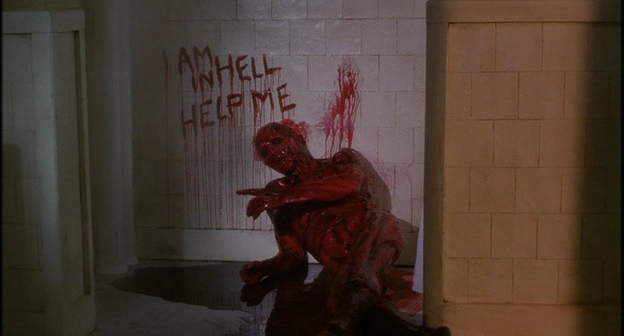
What Doesn’t Work:
Hellraiser II went into production after Hellraiser‘s very successful opening weekend. This had one major drawback — no one had any clue how popular Pinhead was going to become. Logically taking their cues from the first film, instead of fan feedback, Barker and co. didn’t realize what they had. In fact, Barker’s friendship with Doug Bradley is likely the only reason Pinhead was given any special treatment in Hellrasier II whatsoever. Julia is set up to become the ongoing Big Bad of the franchise, with Pinhead and his cronies all getting bumped off rather halfheartedly. I can’t fault the filmmakers for not yet realizing what they had with Pinhead, but I can fault them for making poor use of him. The Cenobites do not make an appearance in the film until 53 minutes into the run-time. This is fine. It is smart not to overuse Pinhead. But the Pinhead we get here doesn’t feel like the Pinhead we fell in love with in Hellraiser. His demeanor is much lighter, livelier and more whimsical, and his dialogue isn’t as spectacularly quotable as it was before (though he still has some doozies). All of our original four Cenobites feel very perfunctory, as if they’re in the film purely because it would be weird if they weren’t — this is most evident in how easily Cenobite Channard kills all four of them. This is a sticky situation, for as we all know Pinhead is eventually ruined by being put front and center in the franchise and converted into something of a Freddy knock-off. Regardless, he is not used as effectively as he could be here, and this holds the movie back whenever he’s on screen. Don’t settle for a B when you can easily get an A+.
Apparently, during production, actor Nicholas Vince, who plays Chatterer Cenobite, injured himself because he was unable to see with his make-up on. So he asked that Chatterer be given eyes. This winds up being a twofold blunder. 1) The character just looks stupid with eyes; his original eye-less look was extremely iconic. 2) They wound up editing out the scene in which the character gains eyeballs, so the first time we see him he is eye-less, and then he just suddenly has eyes the next time we meet. That’s just crap.
Making the Cenobite world Hell feels like a dumbing down move, as though viewers couldn’t grasp the concept of the Cenobite pleasure/pain realm. They were demons to some, angels to other, right? But if they live in Hell, doesn’t that just make them demons? I liked the moral ambiguity of the Cenobites. Now they seem very expressly evil, complete with an arc for Pinhead in which Kirsty gives him the old Werewolf Talk-Down (as I’d call it), pleading with him to try and remember that he was once human. “It is you! You weren’t always this way, you were human once. You were all human! Remember your fear, your confusion!” This whole attitude, and the even more werewolf-esque deaths the Cenobites get – all turning back into humans (though I do like that one turns into a little boy) – borders on silly. Beyond all this, Hell suffers slightly from the paradox that inherently comes with something unimaginable like the Cenobite realm. One of Hellraiser II‘s conceptual strengths is that we get to explore the Cenobite world (you may recall me bitching that after four films we never explored the Tall Man’s realm in Phantasm). But the presentation we get is rather old hat, full of dorky “It’s it crazy?!” bits like Tiffany running through a spooky carnival, or Frank chilling in a little private room of personal punishment, as though Hell were just a big apartment complex. It is tough, as I can’t say what Hell should have been, but this presentation feels uninspired. Mostly, though, I think I just didn’t like that it was Hell; that Frank is being emotionally tormented instead for ripped apart with terrible ecstasy, as though the Cenobites cared about your Earthly transgressions. (Frank is kept in an endless cycle of temptation, surrounded by females writhing under sheets, who all disappear when Frank tries to touch them.)
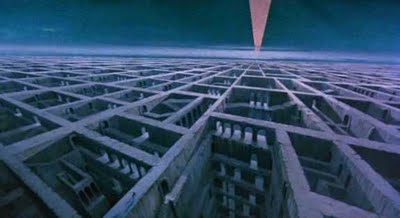
Overall Body Count: 6 (not counting Cenobite deaths and a room full of unexplained corpses at Channard’s house)
Souls Torn Apart By Cenobites: 3
Best Kill: When Julia quite literally sucks the life out of Kyle.
Best Cenobite That Isn’t Pinhead: Cenobite Channard.
Best Badass Pinhead Line: “Your suffering will be legendary, even in hell!”
Best Whimsical Pinhead Line: To Kirsty, when she wants to search Hell for her father. “But please, feel free, explore. We have eternity to know your flesh.”
Most Unpleasant Moment: Definitely when Mr. Browning tries to scrape all the imaginary maggots and bugs off his already scarred and clawed-up flesh with a straight razor.
Should There Have Been a Sequel: Yes. The film ends with a pillar covered in the faces of past characters, including the magical hobo who turned into that stupid flying-bone-demon at the end of the first film, rising from Julia’s bloody mattress — so it seems like things are just getting started.
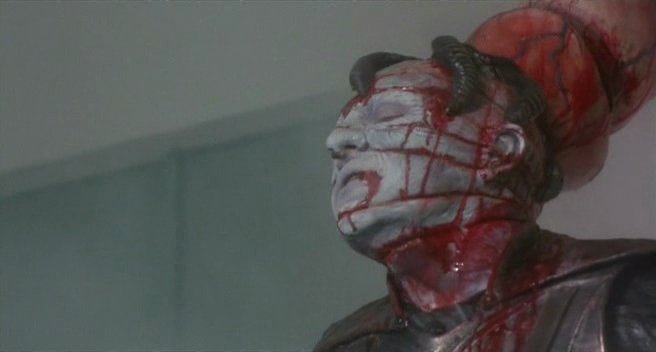
Up Next: Hellraiser III: Hell on Earth
previous franchises battled
Critters
Death Wish
Leprechaun
Phantasm
Planet of the Apes
Police Academy
Rambo
Tremors